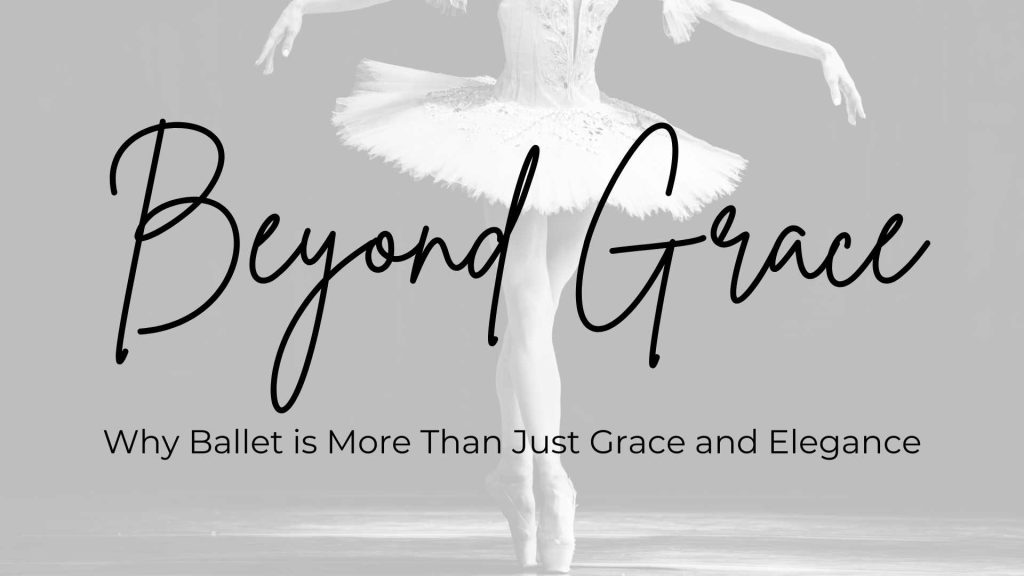By Anagha Madhan
Usually, ballet is seen on account of the last word phrase expression of grace, magnificence, and sophistication. The very fact is, for lots of who lookup the phrases “grace magnificence class dance” on the net, a majority of the pictures that pop up are of ballerinas on stage. Nonetheless, behind every leap, behind every fastidiously positioned pointe shoe, there’s one issue additional raw and innate – one concern hidden that the majority certainly not see. Ballet wears its magnificence as a masks, concealing the extraordinary self-discipline, psychological fortitude, and common laborious work it requires.

Akram Khan’s Giselle
The Illusion of Effortlessness
Here is a question: Is ballet pretty on account of it appears simple, or is it pretty on account of it hides the issue beneath?
Ballet is mostly equated with grace, class, and an aesthetic perfection that is meant to look above the viewers. Dancers intention to float all by means of the stage, and make actions that take years of training to good, look simple and achievable by every single viewers member. Ballet’s true essence, though, lies contained within the connection between what the viewers sees, and what the dancer feels, and by no means contained within the otherworldly actions. Every lengthened movement, exaggerated gesture, every second of suspended magnificence is born from hours of observe, tiredness, and a determined hunt for perfection. Ballet can subsequently be painted as a peculiar distinction, one which hides the fierce with the delicate, a recent masking of vigour.
Reducing ballet to mere magnificence and attraction is a blatant misunderstanding. Whereas positive, ballet does embody a thirst for flawless strains and classy steps, there is a deeper calling for endurance and vulnerability. A relentless push of your physique’s limits. The shock and attraction merely scratches the underside. Ballet dancers are fairly a couple of the strongest athletes spherical, and the within battle to get to that stage, after which push additional to make it look simple, is what defines ballet.

Image: studio R
Historic Origins – Grace vs. Athleticism
Ballet is rooted from the courts of Renaissance Italy, later blossoming in France. As a consequence of this, ballet was and nonetheless is, synonymous with administration, refinement, and sophistication. It is the bodily manifestation of a form of perfection to an viewers – dancers shifting with a fluidity that seems invulnerable to the bounds of the human physique. What isn’t realised, nonetheless, is the extraordinary self-discipline beneath all of this, that was one issue nonetheless simple.
From its inception, ballet has demanded technical precision. This requires dancers to point out their physique intensely and purchase full administration over the smallest muscle tissue. The pure disposition of the physique is completely altered when one trains in ballet. With its emphasis on turnout, going en pointe, and the extension of the limbs, ballet requires utmost vitality first. Attributable to this every ballet dancer is an athlete of their very non-public proper. Nonetheless, on stage, a dancer’s obligation is to convey a story. This narrative requires magnificence and a fragile look, which overshadows the bodily requires positioned on a dancer’s physique. Juxtaposing this intense vitality with the sweetness, grace, and expression required to tell a story on stage, is why anyone expert in ballet turns into appropriately rounded contained in the humanities. Pretty a few olympians, actresses, and people who consider totally completely completely different dance varieties have ballet as a basis, on account of it trains you mentally and bodily, and expects you to do all of it with grace.

Image: Pina Bausch, The Ceremony of Spring
The Energy of The Ideas
Inside ballet lies a extremely fascinating stress – between the need for grace, and the issue to maintain up up it. Ballet, presumably comparatively better than one different work selection, depends upon upon this line between administration and chaos. Every leap, flip, every extension, is the outcomes of muscle tissue straining to their limits, of joints absorbing stress, and the ideas working laborious to coordinate these actions into one concern that appears simple. The viewers will solely see this simple flooring, the illusion of ease and fantastic strains, nonetheless the dancer fights beneath the pores and pores and pores and pores and skin – they battle throughout the course of gravity, fatigue, and the bounds of their very non-public physique.
Grace is solely not the pure state of the physique, it is the ultimate outcomes of self-discipline and battle. Grace is solely not the intention of the dancer, nonetheless a reward for overcoming the bodily and psychological obstacles. The problem to look modern is relentless, and every flawless effectivity is underscored by years of training, rehearsal, and endurance.

Crystal Pite’s Flight Pattern
As a dancer, one should steadily recalibrate their physique and work by way of fatigue – the one reply to push your limits is to go for ‘one completely different’ when your physique says ‘no additional’. That’s constructed by way of observe and persistence. As a ballet dancer, you is perhaps expert to take care of enchancment. It turns into an innate part of you, as you steadily push for additional. Over time, this mentality seeps into all sides of life. Dancers know the one reply to good one concern is to throw your self into the movement, equally, the one reply to get larger at any expertise is to start out out. This drive for refinement, and extra importantly, the willingness to put inside the difficulty to take motion, extends far earlier merely the studio. Ballet teaches you the importance of perfecting methodology, positive, nonetheless it fully moreover fosters the psychological stamina one should beat setbacks and take a look at failures contained in the turning into spirit. It teaches you to try a setback as a step forward, a small victory, contained within the prolonged journey of success. Ballet is one reply to confirm one among many hardest lessons – to embrace challenges as selections for improvement. That’s one concern far easier talked about than achieved, nonetheless ballet teaches you that whereas there’s vitality in mastering the movement, there’s larger vitality contained within the perseverance to push earlier limits, repeatedly.
The psychological facet of ballet is solely as important, if no additional, than the bodily requires. Sustaining focus, administration, and precision, notably when the physique is beneath the stress of stage lights requires fairly a couple of psychological self-discipline. A dancer’s concepts is persistently working a mile a minute to adapt actions in real-time, altering their stability, positioning, or their timing. The ideas should analysis to multi-task – coordinating actions, being aware of the realm it’s in, all whereas sustaining a recent method.
There should even be an unwavering focus that bypasses discomfort since dancers should have the flexibility to push by way of soreness, tiredness, and even harm. Dancers are naturally taught to dam out any distractions and defend a relaxed modern method, notably in intense situations like performances. This psychological resilience turns correct proper right into a necessity everytime you realise that dancers should defend composed beneath the scrutiny of audiences, instructors, and most importantly, themselves.

Image: Mats Ek’s Giselle
Redefining Grace
At current, stylish ballet has actively challenged conventions of perfection, fluidity, tender actions, and symmetrical strains. It proves that embodying grace is solely not static – it is open to interpretation, it might be stretched, and even broken. These new types of ballet shatter conventions and push the boundaries of what we consider “pretty”.
In modern ballet, unconventional choreography embraces stress and imperfection, nonetheless wraps it up contained within the grace of movement. For example, Pina Bausch’s reimagining of Stravinsky’s ‘The Ceremony of Spring’ is an occasion of ballet breaking away from “classical grace”. Choreography is raw and visceral, specializing in human emotion comparatively than a refined class. There could also be an surroundings of chaos, which challenges the viewers’s expectation of grace.

Christopher Wheeldon’s Oscar
Mats Ek’s interpretation of Giselle might be an occasion of ballet pushing earlier the usual connotation of grace. Giselle is portrayed as mentally unstable, and the actions are jerky and exaggerated, embracing vulnerability and exhibiting that grace can emerge from imperfection and human experience. Such performances subvert the considered ballet solely being about attempting “pretty” and invite the viewers to confront harshness and imperfection. Trendy ballet goals to ask: “Why should grace solely exist inside pre-defined strains of customized?”
Ballet has on a regular basis aimed to be an expression of narratives, and being ever-evolving, at the moment it asks whether or not or not or not or not such a pursuit of grace can typically hinder important expression.
Appreciating The Invisible Effort
All this being talked about, it is clear that the sweetness the viewers sees on stage is simply a small part of an intricate, often painful technique of endurance, self-discovery, and ultimately, of expression. The grace we admire is the byproduct of the laborious work of dancers who steadily push themselves above and former, embracing their very non-public complexities as they overcome obstacles.
We encourage you to attempt to respect ballet, not just for the underside magnificence, nonetheless for the laborious work and depth that goes into it. Every effectivity has a wealth of unseen effort behind it. The bodily and psychological labour that goes into making movement into one concern as transcendent as ballet is to not be ignored.
So, I’m going away you with this question – is ballet pretty ensuing from what it reveals, or ensuing from what it hides? Ballet serves as a reminder that there is on a regular basis increased than meets the eye, that the true power lies in between endeavour and attraction, in between vigour and sweetness, and inside the difficulty the dancer conceals to make each effectivity look simple.



This article successfully captures the essence of ballet as both an art and an athletic pursuit. It prompts readers to reconsider their perceptions and appreciate not just what they see, but also what is hidden beneath.
The insights shared in this piece are valuable for anyone interested in ballet. It challenges common misconceptions about the ease of the movements while shedding light on the rigorous training involved behind the scenes.
I found this exploration of ballet quite enlightening. The emphasis on perseverance and mental resilience reveals an important narrative that many might miss during a performance, making it a thought-provoking read.
I appreciate how the author explores the contrast between grace and athleticism in ballet. The discussion about the physical and mental challenges faced by dancers adds depth to our understanding of this art form.
This article presents a compelling perspective on ballet that goes beyond its surface beauty. It highlights the intense discipline and mental strength required of dancers, which many people may overlook when watching performances.